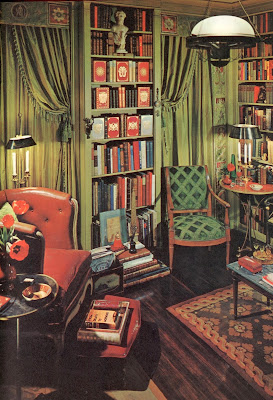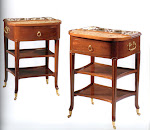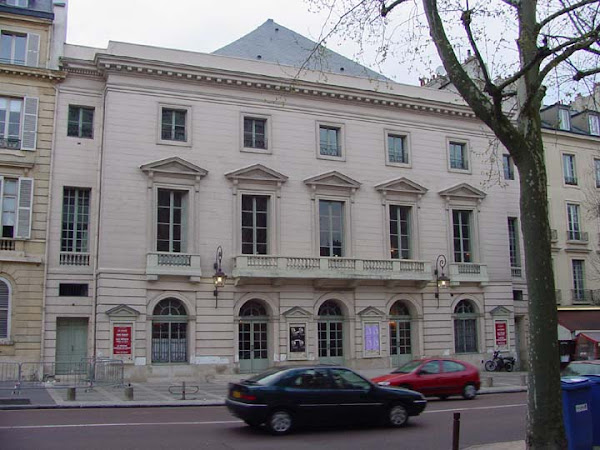In this photo portrait of Michael Greer seen below, from the verso of the dust jacket on his once widely admired book Inside Design (which had at least 6 printings!), we see the young successful designer who, at that wonderfully exciting time in his career had been recalled by one friend after his death as "stunning - tall, slender and witty".
I hope my readers will agree it is regrettable that such a fine, accomplished gentleman of discernment brimming over with, as more than one contemporary assures us, joie de vivre along with an infectious enthusiasm for grand interiors and facile appreciation of l'art de vivre, should more often than not be only scantly remembered today for the brutal and murky circumstances of his gruesome murder in his apartment in April of 1976 at age 60 when he was found strangled to death and tied to his favourite Neoclassical steel bed in the red room of his apartment. A newspaper clipping right after the murder is seen below. It didn't help either that, for reasons I find rather peculiar, when Doyle's auction house in New York City sold his collections of lovely Louis XVI and Directoire furniture and appointments, a piece of case furniture on display during the auction preview was discovered to still have a rather unexpected collection of dildos in it that, it seems, no one thought to remove! Need it be said? The story made the rounds all over New York and still comes up when poor Michael Greer's name is mentioned to the aged over 60 members of the antiques and interior design scene in New York!
Michael Greer should be more remembered and admired by today's lovers and students of l'art de vivre for his rolling off the proverbial log facility when it came to creating ravishing and welcoming interiors for himself and his clients that clearly demonstrate a well educated man of superior taste, an almost instinctive command of information about the history of the great periods of European decorative art and a particularly admirable knack for adapting historical styles to the mood and rhythm of the lives of well to do and sophisticated New Yorkers and other appreciative clients in other American cities of the mid 20th Century. And while Greer did have a vast reserve of carefully acquired familiarity with all the great historical styles, it's obvious when we visit his own apartments that this man particularly gravitated to the joyful French Eighteenth Century - and especially to that particularly chic, clean period of Louis XVI and the Directoire with the occasional toe put into the waters of the First Empire!
That Michael Greer has been nearly forgotten today is genuinely to be lamented. There is much we can learn from him about the art of elegant living from reading Inside Design (which can happily be dug up second hand with a bit of diligence online) and looking at various photos of Michael Greer interiors. However, no matter how much we immerse ourselves in a particular style of the past, it's really nearly impossible to recreate, to the last detail, a perfect Louis XVI or Directoire interior. Nor would even the most ardent collector and enthusiast of the period really want to do so. Modern comforts on which later generations depend would have to go for such a decorative ensemble to be a 100% historically correct recreation. And with domestic help not being available in legions, it's not exactly realistic. That explains, for instance, why Michael Greer did not disdain the use of vinyl flooring when he felt it would be both convenient and effective.
For instance, Directoire inspired as this dressing room may be, it is clearly something that only a decorator working in the 1960's would have created. Perhaps not one of Greer's best moments... But it's still not without historic interest. You can see it below as it appeared as an illustration in Inside Design.
A visit to Michael Greer's own New York City apartments confirms that, like all men who live life intensely and with joie de vivre, he lived life to the hilt and was an inspiration to the people fortunate enough to come into his orbit. His sure footed sense of style puts him in the league of other design legends such as Elsie de Wolfe, Tony Duquette, Billy Baldwin, Stéphane Boudin, Emilio Terry, Georges Geoffroy, Charles de Beistegui, Anthony Hale and David Hicks. This apartment, until a tragic fire which occurred about 1970, was so admired in its day it was featured in the prestigious French magazine Connaissance des Arts twice in the 1960's as he tweaked and improved it with obvious love. This is a view of the living room below which looked into a dining room that could be discerned through the three arches.
This apartment, enjoyed by Greer from the later 50's into the early 70's, already has many of his distinctive touches and his penchant for Neoclassical lines and the use of bouillotte lamps along with tôle peint. The paravent with a grisaille decor on a gold ground is certainly reminiscent of Fornasetti with a strong 18th Century precedent at Haga Pavilion in Sweden. Here are two more monochrome details as published in Inside Design.
The library in this apartment that we see in the image below was particularly welcoming and stylish. I am tempted to compare it to the work of Emilio Terry with it's love of Neoclassicism and clean lines. Here we also have more additions of Directoire and Empire tôle pient and steel furniture.
Worth visiting brielfly is this library seen below for another of Michael Greer's clients. Note the tôle peint sconces flanking the trumeau and the hanging lighting fixture discerned in this monochrome image over the Louis XVI canapé. Both images of libarires are also illustrations from Inside Design.
Another distinctive area of collecting interest and connoisseurship to engage Michael Greer's attention was the use of French steel furniture from the late 18th and early 19th Century. This dramatic steel Charles X period bed from ca 1820-30 was particularly impressive in the photo below which was published in the mid 1960's in Connaissance des Arts. It's almost certain the bed was altered by Greer to suit his use. But no less impressive is Greer's obvious love of historical details. Here he used fabric to recreate the ambience of a Napoleonic campaign tent fit for General Bonaparte himself during the Italian and Egyptian Campaigns! Greer paid assiduous attention to such details as fringes and braids as well as hinges, and other hardware used in fine 18th Century interiors. For this he drew upon his well grounded love and familiarity with French 18th Century design principles.
Photographed in Architectural Digest in the January/February 1974 issue in full colour, it's obvious a mature, more self assured and fully evolved Michael Greer has emerged in this oustanding and elegant apartment which he enjoyed until his death in 1976. Ever the affable host, the magazine hastened to add that when the journalist writing about this apartment in 1974 arrived, Greer had a gathering in honour of the magazine that included Earl Blackwell, Joan Bennett, Eliot Janeway and even the Duchess of Argyll. The AD writer also thought to note that on that same day, Greer was delighted he had just accomplished the purchase of a rare antique desk costing "only $120,000.00". The remaining photos seen below are of Greer's final residence as seen in AD and which begins with a view to the corner of the main drawing room in which an admittedly questionable Louis XV bureau plat (that is either remade from various antique elements or oddly restored) is laden with such tantalizing items as a monumental ormolu inkstand that was understood to have been made for Catherine II of Russia. Another typical Greer detail rooted in the 18th Century is the collection of obelisks. Note the lovely draped Grecian beauty of antique 18th Century terracotta which was among the items salvaged from the fire in the former apartment as was the desk and the inkstand.
Again, when we cast a glance at the photo below from that same AD 1974 article, we know it's the early 1970's when we see such stylish accommodations to subtly hide the stereo and other entertainment items like televisions and LP's of classical music behind built in cabinets and a pair of trellised doors (a nod to Elsie de Wolfe perhaps?) flanking the monumental French 18th Century terracotta allegory of Autumn in the mirrored niche. Note the lovely pair of painted and parcel gilt decorative urns atop each pilaster on each side of the mirrored back of the niche. They are very likely Italian, late 18th Century. Also subtly discernible is the pair of terracotta draped Grecian inspired beauties seen in the mirror and which are clearly in the opposite side of this small lounge appointed in a very embracing welcoming Louis XVI and Directoire luxury that includes fine examples of late French 18th Century steel furniture such as the recycled wash stand next to the side chair seen in the left and the small adjustable table `a dejeuner seen in the foreground along the right next to a very sober but chic Directoire bergère.
Michael Greer's very focused and admirable pursuit of knowledge about the areas of late 18th Century French steel furniture and tôle peint were widely known and his connoisseurship on both subjects were such that among the few reference articles on these subjects still consulted today were authored by him for The Magazine Antiques in the late 1960's. The Charles X period steel bed was salvaged and reused and now set in a powder blue room with a clearly late 18th Century Pecier and Fontaine inspired decor with lavishly draped fabric. Greer loved to reuse lovely 18th Century architectural fragments with which he created curtains and decorations for false windows. The tôle peint hanging lighting fixture is typical Greer as are the outstanding and rare steel chairs and the hauntingly curvaceous rocker that antedates Thornet's bentwood by decades. But in the midst of these eccentric and esoteric decorative fancies, a solid and deeply rooted love and appreciation of the late French 18th and early 19th Centuries resonates
The room, seen in the two illustrations below, in which Michael Greer liked to write and work, was swathed in the most Imperial red digne de Malmaison and sums up the grand Greer style admirably. The attenuated elegance of the fine mahogany late 18th Century French bonheur du jour under the Louis XVI giltwood wall mirror, the Regence caned canapé, the Baltic late 18th Century ormolu chandelier, bouillotte lamps, the steel gueridon, the painted canvas depicting Ganymede and Zeus over the steel Directoire campaign bed and the obelisks not only remind us of a connoisseur who deeply loves and understands the late 18th Century in France and Continental Europe. It's a decorative ensemble created by a gentleman and a connoisseur who had the self confidence of an Emilio Terry or a Georges Geoffroy. If Michael Greer had ever considered other careers, he might have been an admirable theatrical designer!

























No comments:
Post a Comment
Note: Only a member of this blog may post a comment.